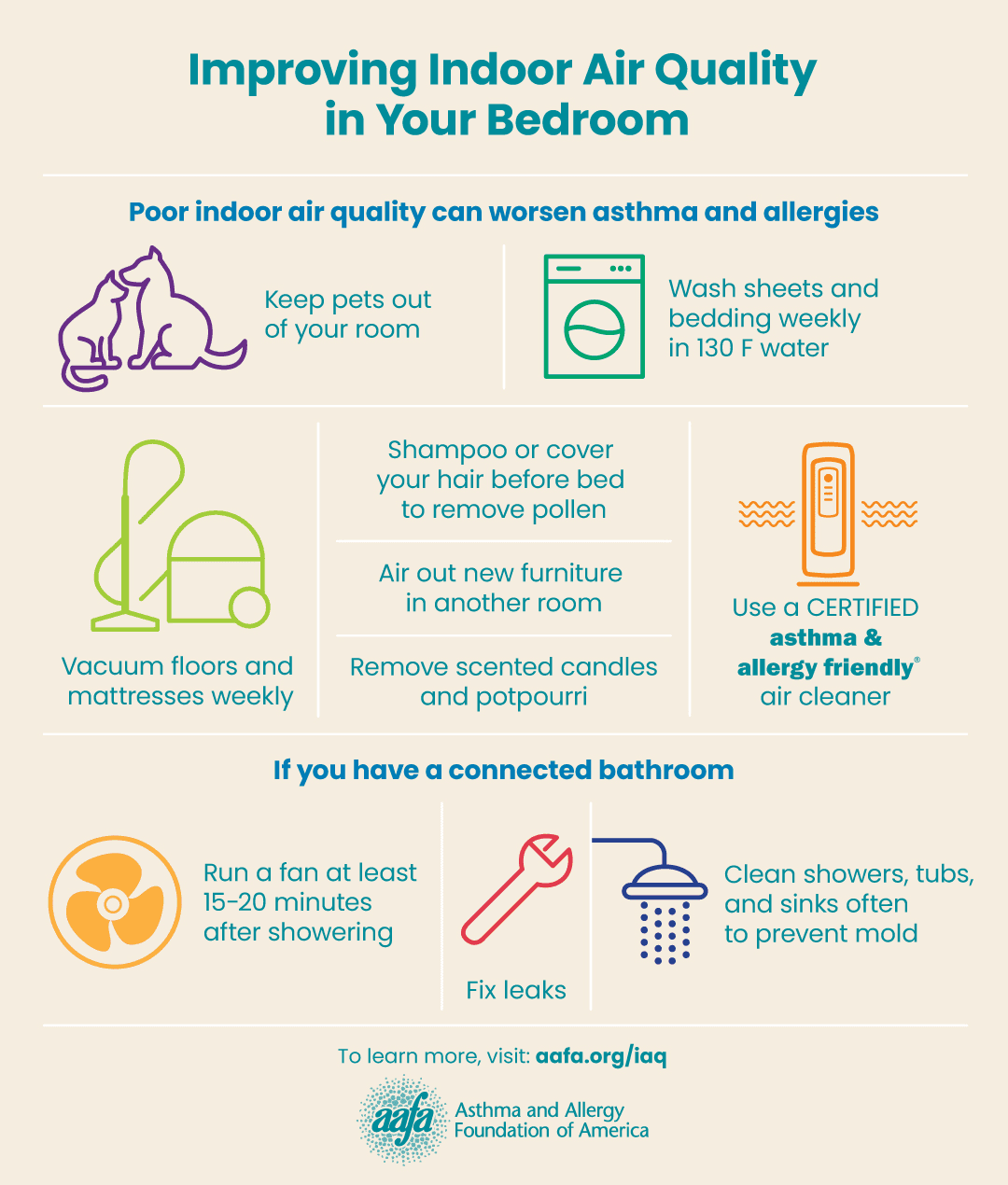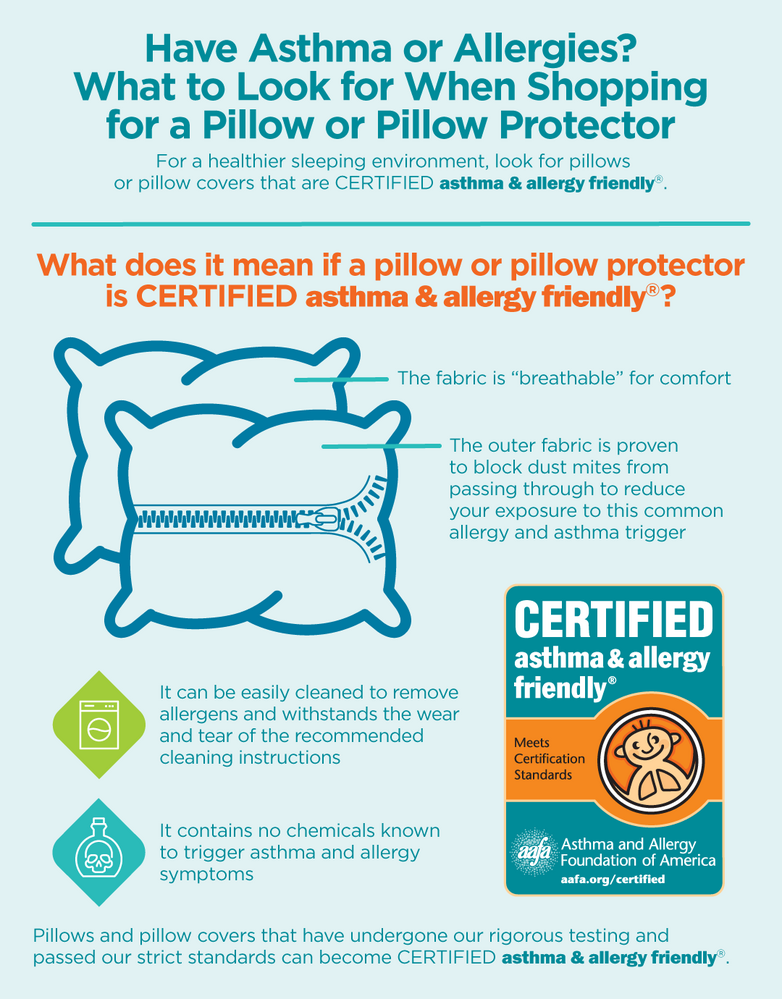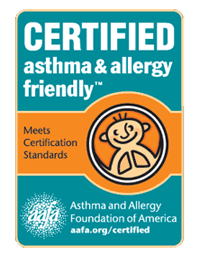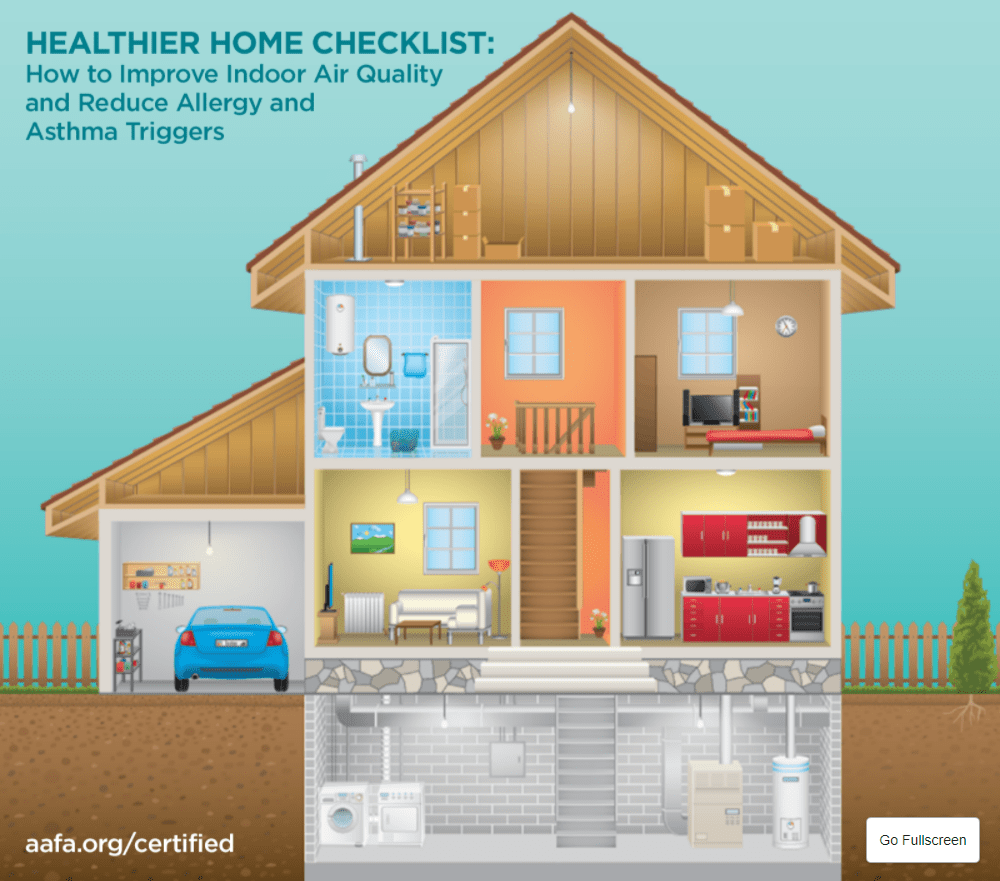Studies show that poor outdoor air quality can worsen asthma and allergies.1 This news may make you think you need to stay indoors to avoid air pollution. But your indoor air may actually be worse than the outdoor air.
Along with taking your medicines, avoiding your asthma triggers and allergens is an important part of asthma and allergy management. And one way to reduce your exposure is by improving and maintaining healthier indoor air quality.
The Truth About Indoor Air Quality
Particles or gasses that are not normally part of the air affect air quality. This is called air pollution. Air pollution can also happen indoors. Why is this?
- Bad outdoor air can enter your home. You bring outdoor air inside any time you open a door or window. You can also bring in pollen and smoke. Leaks around doors and windows can let polluted outdoor air in too.
- Indoor air also has allergens, such as dust, pet dander, and mold.
- Building materials, furniture, carpets, scents, and cleaners can release chemicals into the air.
Clean outdoor air needs to replace indoor air often or else the indoor air becomes more polluted. That means allergens, smells, and pollutants stay in your home and recirculate.
So what can you do to improve your indoor air quality? One of the best things you can do is start reducing asthma triggers and allergens in your bedroom.
Improve Your Bedroom’s Environment
We spend one-third of our lives in our bedrooms. But they can have the worst air quality of any room in our homes. Your bedroom may be full of allergens, asthma triggers, scents, and chemicals.

Reduce Allergens and Triggers
The bedroom tends to have the highest amount of allergens. As you try to improve your indoor air quality, start with your bedroom first. Here are some ways to reduce bedroom allergens:
- Use CERTIFIED asthma & allergy friendly® allergen barrier bedding.
- Wash sheets once a week in 130 F water.
- Keep pets out of your bedroom and off your bed.
- Don’t let wet or damp clothing pile up.
- Replace your mattress every 10 years and pillows every two years.
- Vacuum floors and mattresses weekly.
- Use a CERTIFIED air cleaner.
- If possible, use central air conditioning with a CERTIFIED HVAC filter. If you don’t have air conditioning and the heat is also high, consider going to places like the mall or the library to avoid the poor air quality and the heat.

If your bedroom has a connected bathroom, don’t forget about the allergens in there too.
- Run a fan or vent for at least 15 to 20 minutes after showering to prevent mold.
- Fix leaks in or near sinks, toilets, tubs, and showers.
- Allow towels and washcloths to dry thoroughly after bathing.
- Clean your shower, tub, and sinks often with vinegar or detergent and water to keep mold from building up.
- Clean under sinks and behind toilets often where mold and other allergens may build up.
- If you already have mold, clean it as soon as possible with detergent and water. Wear a mask or have someone else clean it for you.
Keep the Outside From Getting In
When the outdoor air is poor, you’ll want to reduce it from getting inside as much as possible. It’s impossible to keep all outdoor allergens from getting in your bedroom. But there are things you can do to reduce exposure:
- Wear sunglasses and a hat or other hair covering when outdoors.
- Shower every night before bed to keep pollen from getting in your bedding.
- If you work outside, change clothes outside of the bedroom.
- Seal air leaks in windows and doors leading outside and keep your windows closed when pollen is high.
Reduce Scents and Chemicals
Scents and chemicals in your bedroom can affect your air quality. Even pleasant scents, like candles, plug-ins, essential oils, and potpourri, can cause asthma symptoms.
New furniture, especially mattresses, can have a strong scent. This is called offgassing. It is the release of gasses from chemicals called volatile organic compounds (VOCs).
While experts don’t know if VOCs have any long-term effects, they do know VOCs can have some short-term effects. Some VOCs can cause:
- Eye irritation
- Breathing problems
- Dizziness
- Nausea
- Allergic skin reactions2
If you have asthma, let your new bedroom furniture air out in another room or garage before you move it into your bedroom. Remove any plastic or wrappings. You could also check with the company you buy your furniture from to see if they would let your furniture air out in their warehouse before they deliver it.
Paint and new building materials can release VOCs too. So if you remodel your bedroom, make plans to use another room until the scents are gone.
But the bedroom is not the only place asthma and allergy triggers can hide. After you’ve improved the air quality in your bedroom, the next rooms to work on are your living room and kitchen.
Published October 2017. Updated October 2021.
 Many products promise to help control allergens but not all of them do. When you are shopping for products for your home, look for the CERTIFIED asthma & allergy friendly® mark. It indicates the product has passed our testing standards to help you have a healthier home.
Many products promise to help control allergens but not all of them do. When you are shopping for products for your home, look for the CERTIFIED asthma & allergy friendly® mark. It indicates the product has passed our testing standards to help you have a healthier home.Visit aafa.org/certified to search for CERTIFIED products. There you can also learn more about the asthma & allergy friendly® Certification Program.
References
1. Tiotiu, A. I., Novakova, P., Nedeva, D., Chong-Neto, H. J., Novakova, S., Steiropoulos, P., & Kowal, K. (2020). Impact of Air Pollution on Asthma Outcomes. International journal of environmental research and public health, 17(17), 6212. https://doi.org/10.3390/ijerph17176212
2. Volatile Organic Compounds' Impact on Indoor Air Quality. (2017, April 19). Retrieved September 14, 2017, from https://www.epa.gov/indoor-air...t-indoor-air-quality


Comments (0)